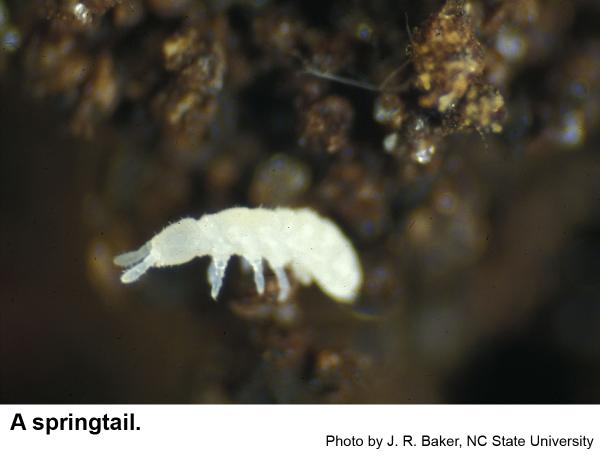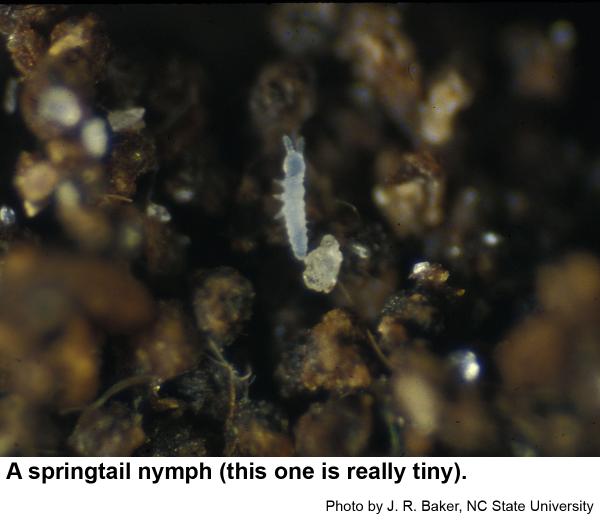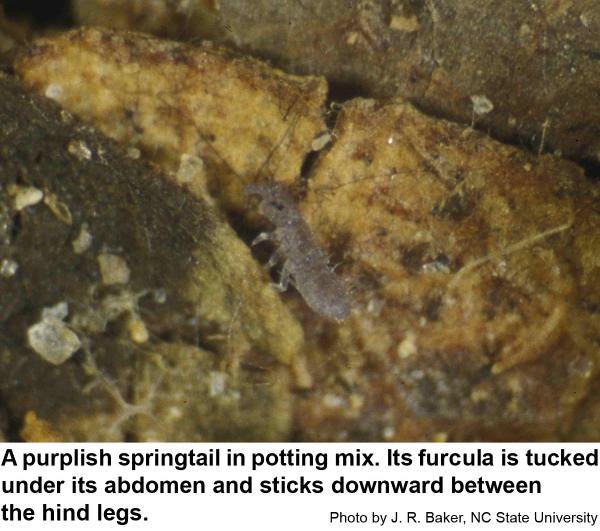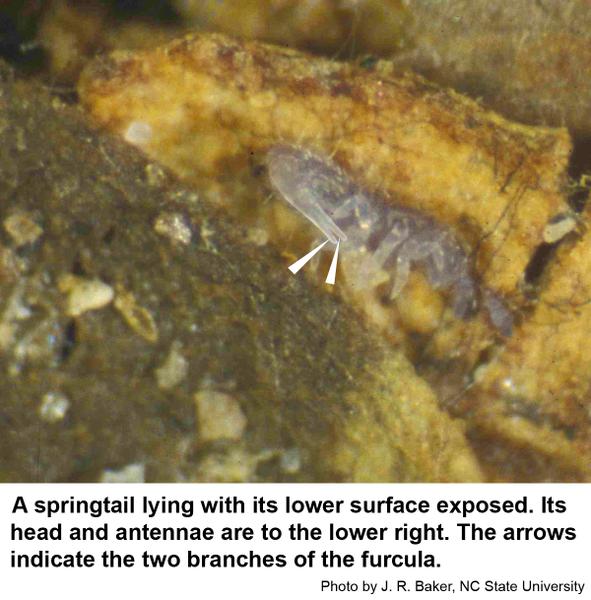General Information
Springtails are in a primitive order (Collembola) of insects in which the adults have no wings and have internal mouthparts. Springtails are so-called because they have a unique structure, the furcula, that allows them to jump for considerable distance relative to their tiny size. Most species are barely visible without a hand lens. Some species are silvery or white whereas others may be light purple, spotted, brown, or black. Springtails are very common and abundant native insects, but they are seldom observed because of their small size and because most of them live in concealed habitats. A few species have been noted as pests in greenhouses, mushroom cellars, or on certain crops in other parts of the world. Most of the time springtails are harmless. As decomposers, they are important to the garden and yard ecology. They are sometimes found on the medium surface of potted plants and in greenhouses.
Biology
Springtails are most often noticed in yards during the spring. Most species live in the soil or in leaf mold, under bark, in decaying logs, and in other damp situations with plenty of organic matter. Males attach a tiny spermatophore on a stalk attached to soil particles. Females straddle the spermatophores and work them into a genital opening. Eggs are laid later singly or in batches that the female sometimes covers. Young springtails molt at least four times before reaching the adult stage. Adults continue to molt from time to time but do not seem to increase in size. Most springtails feed on decaying organic matter but a few are predaceous on other springtails, and fewer actually damage plants. Rarely springtails may become exceedingly abundant and may congregate in heaps several inches high on driveways, sidewalks and poolsides. Springtails are also called "snowfleas" as they sometimes are noticed hopping across snow. Rarely, springtails may become so numerous that they enter houses causing the homeowner undue stress. Springtails do not bite and they require moisture, so they are short-lived inside homes.
Control
Because springtails very rarely do damage inside or around the home, insecticide applications are really not needed. When springtails become obnoxiously abundant indoors, it usually indicates a moisture problem, perhaps leaking pipes, condensation, or overwatered house plants. Reducing the water to houseplants and changing surface mulching of potted plants usually helps. Do not use excessive mulch around foundation plantings. Hosing off hard outdoor surfaces water may give temporary suppression. Soapy water is toxic to springtails. Patience is a good control strategy that works about the same as most chemical treatments and without the expense or risk.
Other Resources
- Springtails. Hahn, J. and S. Kells. 2015. University of Minnesota Extension. Garden Insects.
- Springtails, Household Pests. Waldvogel, M. and P. Alder. 2018. NC State Extension Publications
- The Entoganthous Hexapods. Wallace, M. M. H. and I. M. Mackerras. 1970. pp. 205-216 In The Insects of Australia. Melbourne Univ. Press. 1029 pp.
- NC State Extension Plant Pathology Publications
- NC State Extension Horticultural Science Publications
- North Carolina Agricultural Chemicals Manual
For assistance with a specific problem, contact your local N.C. Cooperative Extension Center.
Publication date: June 1, 2002
Reviewed/Revised: Nov. 12, 2020
N.C. Cooperative Extension prohibits discrimination and harassment regardless of age, color, disability, family and marital status, gender identity, national origin, political beliefs, race, religion, sex (including pregnancy), sexual orientation and veteran status.




